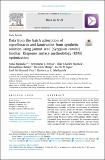| dc.contributor.author | Ripanda, Asha | |
| dc.contributor.author | Rwiza, Mwemezi | |
| dc.contributor.author | Nyanza, Elias | |
| dc.contributor.author | Bakari, Ramadhani | |
| dc.contributor.author | Miraji, Hossein | |
| dc.contributor.author | Njau, Karoli | |
| dc.contributor.author | Vuai, Said | |
| dc.contributor.author | Machunda, Revocatus | |
| dc.date.accessioned | 2023-03-01T08:13:34Z | |
| dc.date.available | 2023-03-01T08:13:34Z | |
| dc.date.issued | 2023-02 | |
| dc.identifier.uri | https://dspace.nm-aist.ac.tz/handle/20.500.12479/1811 | |
| dc.identifier.uri | https://doi.org/10.1016/j.dib.2023.108975 | |
| dc.description | This research article was published by Elsevier, 2023 | en_US |
| dc.description.abstract | This dataset expresses the experimental data on the batch adsorption of ciprofloxacin and lamivudine from synthetic solution using jamun seed (JS) (Syzygium cumini) biochar. Independent variables including concentration of pollutants (10-500 ppm), contact time (30–300 min), adsorbent dosage (1-1000 mg), pH (1-14) and adsorbent calcination temperature (250,300, 600 and 750 °C) were studied and optimized using Response Surface Methodology (RSM). Empirical models were developed to predict the maximum removal efficiency of ciprofloxacin and lamivudine, and the results were compared with the experimental data. The removal of polutants was more influenced by concentration, followed by adsorbent dosagage, pH, and contact time and the maximum removal reached 90%. | en_US |
| dc.language.iso | en | en_US |
| dc.publisher | Elsevier | en_US |
| dc.subject | Jamun seed (Syzygium cumini) biochar | en_US |
| dc.subject | Antimicrobial drug | en_US |
| dc.subject | Response surface | en_US |
| dc.subject | Environmental remediation | en_US |
| dc.subject | Biomass based adsorbents | en_US |
| dc.title | Data from the batch adsorption of ciprofloxacin and lamivudine from synthetic solution using jamun seed (Syzygium cumini) biochar: Response surface methodology (RSM) optimization | en_US |
| dc.type | Article | en_US |

